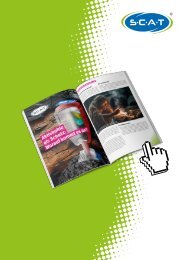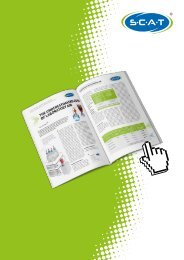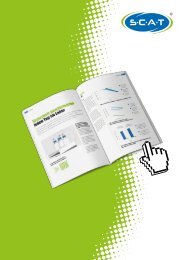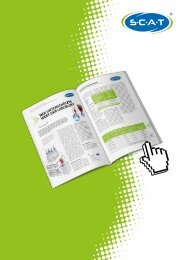SymLine Chemical Waste Systems Catalogue
Create successful ePaper yourself
Turn your PDF publications into a flip-book with our unique Google optimized e-Paper software.
Intro I Electrostatics<br />
Alternatively, the use of conductive or dissipative<br />
materials is recommended, as they discharge<br />
safely when grounded. In this way the prerequisite<br />
for brush discharge, namely charged insulation<br />
surfaces, is not given.<br />
The third type of discharge observed in laboratories<br />
is the propagating bush discharge.<br />
This mainly occurs inside plants and on surfaces made<br />
of insulating material if so-called „strong chargegenerating<br />
processes“ take place simultaneously.<br />
For example, these conditions are present in insulating<br />
tubes through which aerosols or solid particles are<br />
transferred at high velocities.<br />
A tube exposed to the conditions of propagating<br />
brush discharge is generally recongisable by a dark<br />
mark, with a length of several centimetres. At the<br />
centre of the mark preforation of the wall due the<br />
discharge can be seen. A propagating brush discharge<br />
contains enough energy to ignite fuel-air mixtures of<br />
any kind. However, as several conditions are required<br />
for the generation of this type of discharge, the<br />
probability of occurrence is relatively low. If in doubt,<br />
seek an expert opinion.<br />
Using conductive or dissipative grounding materials<br />
avoids insulation surfaces being present. This means<br />
that the prerequisite for brush discharges is no longer<br />
given.<br />
Since propagating brush discharges only occur on<br />
surfaces made of insulating material, the use of<br />
conductive or dissipative transport or conveyor<br />
systems is also an adequate safeguard in this<br />
situation.<br />
Electrostatics and its ignition risks is a very complex<br />
issue. The requirements for components and parts<br />
used in so-called hazardous areas, i.e. zones in which<br />
flammable atmospheres occur frequently and to a<br />
great extent, are effectively regulated.<br />
But even in areas with high air exchange and<br />
lower solvent volumes which are not defined as<br />
hazardous zones, care must be taken to avoid creating<br />
electrostatic ignition sources near emission points or in<br />
areas of handling solvents. An electrostatic discharge<br />
occurring in this area would inevitably cause the<br />
mixture to ignite and, in a worst-case scenario, would<br />
cause the container to explode.<br />
Instead, this emission should initially be avoided by<br />
using suitable filtration systems. If this is not possible,<br />
care must be taken to ensure that no electrostatic<br />
hazards can be created near solvent emission points or<br />
in areas where these substances are handled (i.e. waste<br />
solvent collection points).<br />
In order to do so, it must be ensured that not only the<br />
previously specified safeguards for solvent systems<br />
are applied, but also additional mitigations such as<br />
grounding of operators through dissipating floor mats<br />
www.symline.de<br />
24


















